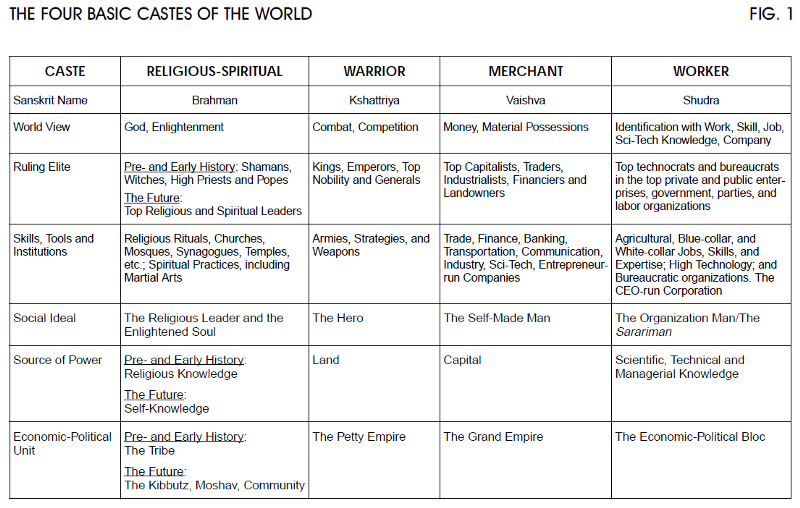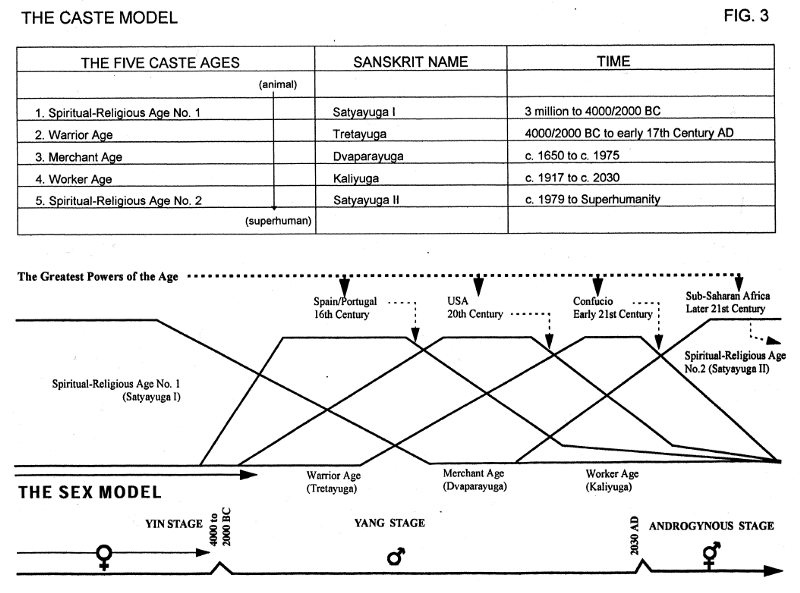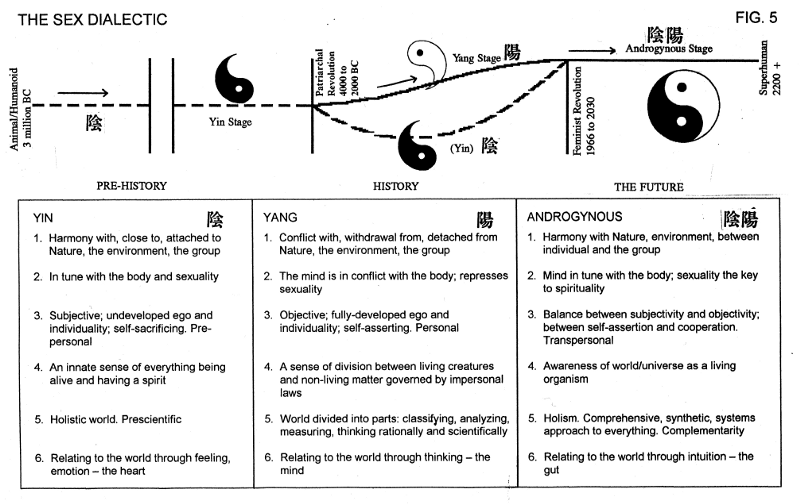Transcending the Left-Right Divide
Source
This is the text, with graphics, written by Jan Krikke on the work of the great futurist Lawrence Taub.
URL = https://medium.com/@jankrikkeChina/transcending-the-left-right-divide-795e1132a752
Text
Jan Krikke:
"Twenty years ago, the American macrohistorian Larry Taub published his book The Spiritual Imperative: Age, Sex and the Last Caste. The Japanese edition of the book made it to the top of the best-sellers list in Japan. Taub reached only a small audience of specialist in the West, perhaps because he takes a non-Euro-centric view and transcends the traditional ideological Left-Right divide that has shaped much of Western thought in the past 200 years.
Macrohistory, or Futurism, was popular in the second half of the 20th century. Toffler saw humanity evolving from hunter gatherer, agricultural, industrial to post-industrial society. Fukuyama considered the fall of Soviet Union as “the end of history.” The “free market” had won. Paul Kennedy described the rise and fall of civilizations, and Samuel Huntington argued that the source of conflict in the future would not be primarily ideological or economic but cultural.
All these macrohistories had a kernel of truth but did not tell us the whole story. Toffler predicted the emergence of post-industrial society, but his model cannot pin-point the geographical center of post-industrial society. Fukuyama took an ideological-economic view and ignored culture as a force in history. Huntington took culture into account but ignored economics. He divided the word in nine religious-cultural regions: Western, Orthodox (Russia and South-Eastern Europe), Islamic, African, Latin American, Sinic (China, Vietnam and Korea), Hindu, Buddhist and Japanese.
Huntington, like his peers, does not give us the tools to orient ourselves in the future — where will change be most profound and when will it happen. “Conventional” macrohistories relied on a linear model: we came from A and went to B and will go to C. Taub’s marcohistory consists of three sub-macrohistories — Sex, Age and Caste. They are three “parameters” that enable us to orient ourselves in time and space. While Toffler gives us a road map, Taub gives us a GPS system.
Caste
The center piece of Taub’s macrohistorical model is the ancient Indian notion of Caste. To understand the original meaning of Caste, we have to forget everything we ever learned about the oppressive social construct developed in later centuries in India, the Caste System, which is a corruption of the original notion of Caste. Understanding the notion of caste requires an understanding of the values-free concept of “generic type.” This is a crucial concept in Asia thought.
A useful stepping stone to understanding a value-free generic type is the Chinese example. The Chinese world view starts with the premise that Nature is based on two generic opposites, yin and yang, the “constituent” part of Tao. The Chinese used these generic types to identify all conceivable opposites in nature, both concrete and abstract. The Chinese reasoned that if nature is based on two primary opposites, they would do well to study this two-fold structure of nature. It would enable them to “insert” themselves in the binary universe with a minimum amount of friction.
Humans are part of but distinct from Tao (nature). Tao operates on a binary principle but it does not know the difference between human opposites like male and female, good and bad, physics and meta-physics, matter and spirit, space and time, etc. That means humans have to resolve these opposites in their own mind. The aim of the notion of Tao is not to change the world but to change ourselves. The I Ching is value-free and non-ideological. It is a psychological manual to help us come to terms with the distinction between Tao and human.
The Indian notion of Caste is likewise based on genetic types. The Hindu word for caste is “varna”, meaning color. It was mistranslated by the Portuguese as “casta” and the name “caste” stuck. The ancient Hindus identified four generic human traits or tendencies: the religious or spiritual type, the warrior type, the merchant type and the worker type. Each caste type has its own dominant characteristic, and every human, both male and female, has affinity with one of these four categories. An individual may have traits of two, three, or four caste types, but one of the four usually dominates within an individual. It is the dominant “psychological profile.”
We leave aside whether these traits are nature or nurture or a combination of both. Taub’s diagram of The Four Castes of The World shows the defining features of the four castes — their world view, ruling elite, source of powers, etc. If we look at their modern equivalents, we see that all four castes play a role even in modern society.
The ancients Hindus, like the Jewish, Christians and Muslims, prophesied about the destiny of humankind. The Hindu sages predicted that the four castes take turns in “ruling the world,” in cycles they called yuga. All the while, the four caste types remained mutually dependent. A society can not only consist of spiritual types, worker types, merchant types or warrior types. All are needed, but they take turns in being “leaders of their age,” because their attributes and world view are most effective in a given yuga.
Taub gave the ancient Hindu prophesy a remarkable twist. While the Indians spoke of an endless cycle of yuga, Taub “mapped” this cycle to actual historical phases, and he did so with a high degree of geographic precision and “moment” (space and time). He illustrates this development in the second diagram: The Caste Model.
In prehistory, during the animistic age, the Spiritual Caste ruled the world. Shamans, witches and the early priests were the “ruling elite” of their days. The next caste to rule the world was the Warrior Caste. Its ruling elite were Kings, Emperors and military leaders (the rise of the Warrior Caste overlaps the of age of the Great Patriarchs). The last great power of the Warrior Caste Age was Spain. Today, remnants of the Warrior Caste Age survive in monarchies and military rituals like the honor guards at state visits.
The reign or the Warrior Caste came to an end with the revolt of the Dutch merchants against Spanish domination. The Dutch developed the first stock market and the first “multinational” company (the VOC). The dominance of the Dutch Merchant Caste was short. They were overtaken by England, who in turn was overtaken by the US. In Taub’s model, the US is the last of the great powers of the Merchant Caste Age.
The beginning of the end of the Merchant Age already started in the 19th century. Workers organized to resist the merchant caste. They formed utopian socialist communities, anarchism, communist movements, political parties and trade unions. We are now in the midst of the Worker Caste Age. Remnants of the Merchant Caste (financiers, rent-seekers, etc.), are the last vestiges of the resistance against the Worker Caste Age.
The Protestant work ethic was part of the transition from the Merchant Caste to Worker Caste Age. In the Merchant Castes Age, family name, land holdings, money and wealth defined one’s status in society. Today, most people are defined by, and identify with, the work they do. “What is your job?” is commonly the first question people ask when meeting others. “He is a hard worker,” is a commonly used expression to value work. The Worker Caste identifies with professional skill, knowledge, job or company.
While the Worker Caste uprising against the Merchant Caste started in Europe, Taub shows that East Asia will become the dominant power of the Worker Caste Age. The people of East Asia most closely resemble the generic Worker Caste type — they value team work, cooperation and sacrifice of the self for the benefit of the group. These Worker Caste attributes, according to Taub, will make East Asia the leading power in the peak stage of the Worker Caste Age, which he anticipates will come by the year 2050.
Taub, like the ancient Indian sages, does not attach value judgment to the Caste Model. He points out that each caste age brought humanity to a higher level, while each caste age also had its dark side. The Warrior Caste helped humanity to emerge from animistic submission to and fear of nature, but it also produced weapons of war, conquest and human slaughter on an ever-greater scale. The Merchant Caste advanced science and technology, but also produced colonialism and exploitation. The Worker Caste ended slavery and fought for human rights but was also preoccupation with materialism and overconsumption.
In Taub’s model, the Worker Caste Age will be the shortest of the four ages. It is characterized by hypermaterialism, in large part driven by the science and technology developed by their Merchant Caste predecessors. Sci-tech has provided creature comforts, cars, trains and planes, computers and mobile phones to half of the planet’s population. The Worker Caste will remain dominant until “the other half” has similar creature comforts.
“Free trade”
A look at contemporary developments in the world shows Taub’s Caste Model in action. In the second half of the 20th century, the world’s most Worker Caste minded region of the world — East Asia — made its presence felt, beginning with Japan in the 1970s. Using its Worker Caste teamwork spirit, Japan became an economic juggernaut. Its (consumer) electronics industry virtually wiped out its Western competitors (RCA, Philips, etc.). Japan’s automobile industry nearly did the same. The Toyota juggernaut could only be stopped by imposing “voluntary export restrictions” until Western car makers could match Japanese efficiency.
In the 1980s, the United States experience a “silent” coup d’état by the remnants of the Merchant Caste Age. The convinced the political establishment to “liberalize” the market and “free trade” became the mantra of the captains of industry, who would become the financiers of the American political system. They financed “think-tanks” staffed with economist to extoll the benefits of free trade, without ever offering a lucid definition of what free trade is and whether it had limits. Free trade does not exist except between borderless states. All trade between countries is managed trade, often governed by treaties covering thousands of pages.
Free trade, embraced by both the political left and right, meant that companies could move capital abroad and profit from lower wages while leaving workers at home to fend for themselves. No measures were taken to deal with the effects of free trade — the eroding tax base, the growth of unemployment, the rise of “tax heavens” and the overall social dislocation. Charts tracking the growing wealth disparity, poverty rates, trade deficits and the rise of the US national debt show a direct correlation with the beginning of free trade and financial liberalization
Imposing free trade on the country was the last hurray of the Merchant Caste. Its primary beneficiaries were financiers — and China, the Worker Caste nation par excellence. While millions of Americans sank into poverty if not despair, China pulled 600 million people out of poverty, became the largest trading nation and replaced the US as the world’s largest producer of electronics. All the while, China accumulated a total of about 1.5 trillion dollars in US debt. Some economists argue that the US needs China’s help to rebuild its infrastructure.
And then came Trump, the personification of a Merchant Caste type but with a nationalist bend. Most of his voters didn’t know the intricacies of global economics and finance, but they had a gut feeling that something was wrong with the system that was created by the political (left and right) establishment. Trump, rather than a wise statesman, was wrecking ball who promised to wreak havoc to the status quo.
Being a billionaire rather than a lawyer, he understood money. He knew that China pragmatically and ruthlessly exploited the free trade system. A continuation of the status quo would have resulted in the US gradually becoming economically dependent on China. The US already relies on China for much of its electronics. Could artificial intelligence, aviation and biotechnology be far behind? Will western workers soon be sweeping up around Chinese computers, rely on Chinese bankers and their livelihood reduced to service industry jobs catering to Chinese tourists?
Trump knew the answer. He is most of the bad things they say about him, but he understands money. He knows that ideological niceties are no match for the Chinese juggernaut. China blended quasi-communism and free enterprise with a nationalist sauce. It has moved in the post-ideological era, all the while seeing the US as the gift that keeps on giving. The nationalist and non-ideological Trump is their biggest challenge yet. (As David Li astutely observed: Trump is the first US president to take China seriously.)
Trump come too late to stop the Chinese juggernaut and will have to content with damage limitation. The irony of it all is amplified by the Caste Model. Trump, the personification of the Merchant Caste type and leader of the last great Merchant Caste power, is taking a last stance against the next great Worker Caste power while championing jobs for the Worker Caste at home, thereby defying an ideological pigeon hole.
Taub’s Caste Model requires a significant mental hurdle, but his Sex and Age Models “buttress” the Caste Model. The Sex Model is vulnerable to critique but the Sex Model is manifest in today’s world: the evolving role of women, which is typically overlooked by other macrohistorians. Taub’s diagram on the Sex Model is largely self-explanatory. Women are gradually undermining the patriarchal structures that still dominate in many countries, not only in developed societies but also in developing, male-dominated countries in the “religious belt” and in Africa. Taub argues that East Asia is more yin than yang, adding a sexual parameter to his GPS system. The Sex Model, like the Caste Model, is non- or rather post-ideological. The growing importance of women is an inevitable part of human history.
The Worker Caste Age has yet to reach its peak, but the pioneering stage of the next Caste Age, Spiritual Caste Age II, has already begun. It manifested itself in the 1960s with the counter-culture movement, growing interest in Eastern spirituality, feminism, the broader New Age movement and indeed P2P. Many of those having benefitted first from the products of the Worker Caste age are already starting the turn away from materialism and look for meaning and purpose. This leads to surprising results. Yoga practices developed in Asia are modified and enriched by the pioneers of the new Spiritual Caste Age in the West and in some case “re-exported” to the East.
Welcome to the Spiritual Caste Age II, but as Taub shows: The road to Nirvana passes through the land of the Worker Caste."


